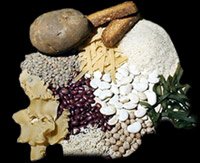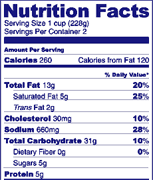The following chapter is an excerpt from Jeremy's eBook, "Become the Journey: A Transformation Guide" that can be downloaded at www.becomethejourney.com.
It is important that you know how to shop for quality foods. This section explains how to maximize your trips to the grocery store by revealing exactly how to read labels and find healthy foods. It is not very complicated, but a little knowledge can go a long ways when it comes to healthy shopping.
Here Are A Few General Guidelines For Looking At Food Labels:
- It is the ingredients and the nutrition facts that are important - one without the other doesn't tell the full tale.
- Ingredients list are listing in descending order of predominance. This means that the first ingredient is the most prevalent in the product, while the last ingredient has the least amount in the product.
- In general, you'll want sugars and salts to be listed last in the ingredients list
- If you are looking for a whole fat food, remember that the labels list fats in grams. The percentage listed next to the fats is percentage of daily intake, not percentage of fat calories in the product. You need to look at the top of the label, "calories of fat", and divide that by total calories to figure out the percentage. You can estimate this - if the fat calories are around half of the total calories, then the fat calories are about 50%.
- When looking for carbohydrate products, try to choose products that are the least amount processed.
Here are a few tips:

- Breads should have the words "whole" or "stone ground" first on the ingredients list. Often, you might see "unbleached enriched flour, whole wheat..." which is not the bread you are looking for - this is processed bread with some whole grains added for color. The first ingredient should be whole grains.
- A quality carbohydrate should have fiber and sugar. Try to avoid carbohydrates with zero fiber. Carbohydrates that are nothing but fiber will also not provide optimal nourishment- a combination of both is good. I typically look for at least 1/6 of the total carbohydrate count as fiber - so something with 20 grams of carbohydrate would have around 3 - 4 grams of fiber.
- It is your decision whether or not you wish to consume highly processed foods. I choose to look for whole, natural foods. If there is too much Latin on the label - i.e. Ingredients I can't pronounce or don't recognize, I leave it on the shelf!
- Canned goods, frozen dinners, and other pre-packaged items are typically very high in sodium. You are better off purchasing the whole, individual ingredients and then making your own meals from recipes. You can store these in containers and freeze them for later.

i. Shuffling Ingredients

Foods are often "grouped" on ingredients lists to present the items in a specific way. Sometimes this is for legitimate reasons, and sometimes it can be downright tricky. Most people understand that ingredients should be listed in descending order of quantity - in other words, the ingredient that occurs the most in the product should also be listed first. Therefore, someone looking for a protein bar will be happy to pick up something that reads:
super-di-awesome Protein blend (hydrolyzed cow toes, whey), maltodextrin
The label will list protein, and zero sugars.
Of course, there is more going on here. That special protein blend - what is it, really? Let's say our ingredients list had 10 grams of whey, 11 grams of cow toes (ew!) and 12 grams of maltodextrin. That list would need to be in descending order of quantity, or "maltodextrin, hydrolyzed cow toes, whey."
Anyone familiar with sugars knows that while maltodextrin doesn't affect the sugar count, it is very high glycemic and therefore not something you would want to be the primary ingredient (unless this was a post-workout shake). So looking at this label, the average consumer would say to themselves, "High in sugar, tons of poor protein, and only a little whey."
So what to do? Simple. The company groups the cow toes and whey together. This is the "super-di-awesome protein blend." Because the sum of the ingredients is 10 + 11 = 21, this new "blend" can be listed before the maltodextrin, with the components of the blend listed in order.
Now, it appears to the unsuspecting consumer that there is actually more whey in the product than maltodextrin (sugar). But we know there is less! The whey makes its way (pardon the pun) to the front of the list through the use of the blend. Therefore, when you are checking out labels, make sure you are aware of how this grouping works.

ii. Special Statements

Sometimes label contain special statements. It is important to understand exactly what these mean.
When a label states, "Not a significant source of calories from fat," it must have less than 0.5 grams of fat per serving. Be cautious of deli meats that are sliced so thin that they may have less than ? gram of fat per serving, but still contain a significant percentage of calories from fat.
"Not a significant source of sugars" means that the sugar count on the label is less than one gram. Don't take this statement for granted. Some ingredients, such as maltodextrin, are not technically considered to be sugars, but have the same effect as sugars. This is why the ingredients list and the nutrition facts are important when taken together.
The following table provides the definitions for other special statements:
No Fat Or Fat Free Contains less than a 1/2 gram of fat per serving. Lower Or Reduced Fat Contains less the fat or calories of the original version or a similar product. Low Fat Contains less than 3 grams of fat per serving. Lite Contains 1/3 the calories or 1/2 the fat per serving of the original version or a similar product. Low Calories Contains 1/3 the calories of the original version or a similar product. No Calorie Or Calorie Free Contains less than 5 calories per serving. Sugar Free Contains less than 1/2 gram of sugar per serving. No Preservatives Contains no preservatives (chemical or natural). No Preservatives Added Contains no added chemicals to preserve the product. Some of these products may contain natural preservatives. Low Sodium Contains less than 140 milligrams of sodium per serving. No Salt Or Salt Free Contains less than 5 milligrams of sodium per serving. Baked Not Fried Used mostly for potato chips, crackers or corn chips, this label means the product is usually sprayed with a light oil then baked in an over instead of fried in the oil. 
iii. Sugars by Any Name

Understand how to locate sugars in your foods. I am not against sugars, as you read in previous chapters, but it is important to know how to find these if they do exist. Here are some common names for sugars. Be cautious with foods where these appear higher in the ingredients list, as the foods may contain too much sugar and create undesirable spikes in your blood sugar:
- Cane juice
- Custard powder
- Falernum
- Fructose
- Glucose
- Honey
- Jaggery
- Jus de canne
- Lactose
- Levulose
- Malt
- Maltodextrin
- Maltose
- Marshmallow
- Misri
- Molasses
- Orgeat
- Panocha
- Sorghum
- Sucrose
- Sugar
- Treacle
- Turbinado
- Zuckerhut

iv. Dairy Derivatives

If you are avoiding dairy, the following elements on an ingredients list are dairy or dairy derivatives:
- Cream
- Cheese
- Butter
- Yogurt
- Koumiss
- Kefir
- Ghee
- Paneer
- Lactose
- Casein - Learn More
- Whey - Learn More
- Rennet
- Rennin

v. Natural & Artificial

There seems to be a lot of fuss over having natural versus artificial flavorings. It seems that many products are proud to brag "natural flavors" on their ingredients, while consumers are quick to erect a stake and start building a pile of sticks to burn anything that remotely mentions something as "artificial." The truth about these ingredients, however, is not what you think! So what exactly is the difference between natural and artificial flavors?
Natural and artificial flavors are defined by the Code of Federal Regulations. This means there are specific laws regarding which of these terms can be used on an ingredients list.
In order to be considered "natural" an ingredient must adhere to the standard that:
"a natural flavor is the essential oil, oleoresin, essence or extractive, protein hydrolysate, distillate, or any product of roasting, heating or enzymolysis, which contains the flavoring constituents derived from a spice, fruit or fruit juice, vegetable or vegetable juice, edible yeast, herb, bark, bud, root, leaf or similar plant material, meat, seafood, poultry, eggs, dairy products, or fermentation products thereof, whose significant function in food is flavoring rather than nutritional."Anything that does not follow this definition is considered artificial. Quite a mouthful, no?
There is actually a trained professional, known as a "flavorist," who creates these ingredients. What may surprise you is that both natural and artificial flavors are made in a laboratory! That's right - the flavorist actually uses the same chemicals to make natural or artificial flavors. Read what others think of different bars. The difference is that the chemicals are either naturally derived or synthetically created. This is not like the difference between wool and nylon, which are both used for making clothes but are different substances.
At a molecular level, natural and artificial flavors appear to be the same. In fact, there is an argument that artificial flavors are safer. This is because they can be created in their pure form. For natural flavors, the source product (for example, an apple) must be dissolved and filtered, even treated with other chemicals, in order to yield the chemicals for the flavoring. This creates a greater potential for impurities to exist in the flavoring.
It is therefore wise to note that natural and artificial flavorings are both chemical additives used to enhance flavor. If a product indicates that it contains a natural flavor, that does not mean the vendor ground their apples to flavor the product - it means they purchased or extracted a specific set of chemicals and artificially added these to the food to alter the taste.
If you are not concerned with flavorings, then pay less attention to whether the source is natural or artificial, and more attention to the position in the ingredients list. If you want a natural food in the sense that it is something you could produce in your own kitchen, ditch the packages that have any added flavoring other than natural spices.

vi. Red Flags

There are certain red flags to look for in an ingredients list. This is by no means a comprehensive list, but a recommendation based on my own experience with purchasing quality foods. When looking at an ingredients list, examine the beginning (initial ingredients), the middle, and the end of the list.
Here Is My List Of Red Flags:
- Sugar anywhere but the end. Middle is fine if there is also substantial fiber. Of course, these rules may change for a post-workout shake.
- Salt anywhere but the end of the list. Salt is not bad (see my "The Skinny on Salt" article) but should be used in moderation
- Any ingredient that I can't pronounce or must understand Latin in order to decipher - again, these aren't necessarily bad I just ask myself do they do something good for me?
- Excess vitamins and minerals - I'd rather get these from whole foods and a well-designed multivitamin than as a spray or additive in my food
- Enriched anything. This has to be the biggest joke in the food industry. Enriched means the food was stripped of vital nutrients, and then a half-baked attempt at stuffing some more back in was made
- Fortified. Fortified with what? Control your vitamin and mineral intake through engineered supplements and whole foods - not through additives to existing foods where you do not have control over the quality or quantity
- Any food where the serving size provides over 20 grams of carbohydrate but less than 2 grams of fiber
- A protein where the fat calories are half of or more than the total calories (unless, of course, you are looking at a bottle of olive oil)
- The existence of partially hydrogenated oils anywhere in the ingredients list (also known as trans-fatty acids). I also tend to avoid hydrogenated oils as well (as opposed to partially hydrogenated) but don't mind them if they are at the end of the ingredients list. Also, if a product declares that it is free of trans fatty acids, then it should be fine despite the presence of hydrogenated oils in the ingredients list.
Educate yourself regarding foods will help you tremendously in your journey to fitness. As with all things, practice moderation. For example, my weakness is fried corn chips.
I still consume these, in moderation, by keeping them within my calorie budget and avoiding multiple servings per day or consuming them daily. When I have a strong craving for chips, I will purchase the baked variety (usually spiced with lemon and chili pepper) as a compromise.

Conclusion

I want to leave you with one final piece of advice that I learned from many other sources. It is called "shopping at the periphery."
If you notice, most stores put the processed, packaged, and canned goods in the middle of the store. The fresh produce, eggs, dairy, meats, and other whole items are around the perimeter of the store. As long as you focus the majority of your shopping on this perimeter, you will be doing very well at picking up healthy, wholesome foods.
 This article is just one chapter of more than thirty from my eBook, "Become the Journey: A Transformation Guide." You can learn more about this exciting physique transformation eBook and purchase your copy by visiting www.becomethejourney.com.
This article is just one chapter of more than thirty from my eBook, "Become the Journey: A Transformation Guide." You can learn more about this exciting physique transformation eBook and purchase your copy by visiting www.becomethejourney.com. - When looking for carbohydrate products, try to choose products that are the least amount processed.

